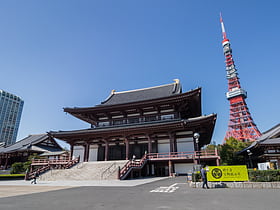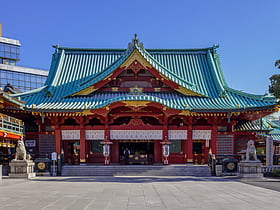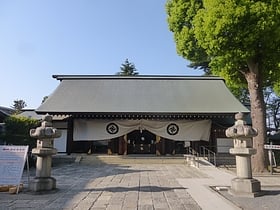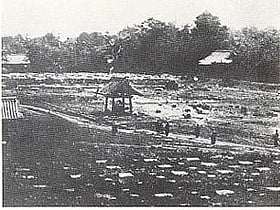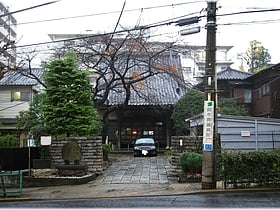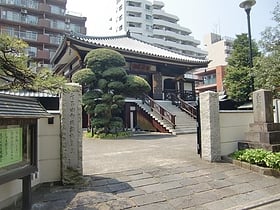Tokyo: Sacred and Religious Sites
Places and attractions in the Sacred and religious sites category
Categories
- Museum
- Park
- Temple
- Art museum
- Sacred and religious sites
- Neighbourhood
- Shopping
- Amusement park
- Theater
- Skyscraper
- Concerts and shows
- Universities and schools
- Buddhist architecture
- Specialty museum
- Nightlife
- Area
- Architecture
- Historical place
- Shopping centre
- History museum
- Garden
- Amusement
- Concert hall
- Sport
- Music venue
- Sport venue
- Theme park
- Music and shows
- Amusement ride
- Buddhist temple
- Arenas and stadiums
- Bridge
- Library
- Art gallery
- Modern art museum
- Event space
- Palace
- Dancing
- Tower
- Science museum
- Observation decks and towers
- Church
- Forts and castles
- Business center
- Botanical garden
- Convention center
- Entertainment district
- Sport complex
- City
- Cemetery
- Monuments and statues
Sensō-ji
Historic temple to the goddess of mercy Sensō-ji, an ancient Buddhist temple located in the historic Asakusa district of Tokyo, Japan, is the city's oldest and one of its most significant religious sites. The temple, associated with the Bodhisattva Kannon, or Avalokitesvara, attracts millions of visitors...
Zōjō-ji
Buddhist temple complex dating to 1622 Zōjō-ji is an iconic Buddhist temple located in the Minato district of Tokyo, Japan, offering a serene escape amidst the bustling cityscape. Founded in 1393 as the main temple of the Jodo sect of Japanese Buddhism, it has stood as a spiritual center for centuries...
Kanda Shrine
Enduring shrine with red and gold decor Nestled in the bustling district of Chiyoda in Tokyo, Japan, the Kanda Shrine stands as a serene oasis amidst the urban sprawl. Known in Japanese as Kanda Myojin, this Shinto shrine has been a spiritual cornerstone for the local community and visitors for centuries...
Holy Resurrection Cathedral
Nestled within the bustling metropolis of Tokyo, Japan, the Holy Resurrection Cathedral, also known as Nicholai-do, stands as a spiritual haven and architectural marvel in the Chiyoda special ward. This cathedral is the main cathedral of the Japanese Orthodox Church...
Oji Shrine
Nestled in the heart of Tokyo, Oji Shrine is a serene oasis steeped in history and tradition. This Shinto shrine, not as widely known as some of its more famous counterparts, offers a tranquil escape from the bustling city life and a glimpse into Japan's rich cultural...
Hanazono Shrine
The Hanazono Shrine is a Shinto shrine located in Shinjuku, Tokyo, Japan. This shrine was founded in the mid-17th century. Hanazono Jinja nestled in the heart of Tokyo's Shinjuku ward, Hanazono Jinja is a small and unobtrusive structure that, according to Fodor's, just happens to be one of the most historical shrines in Japan.
Karasumori Shrine
Karasumori Shrine is a Shinto shrine located in Minato, Tokyo. It enshrines Ukanomitama, Ame-no-Uzume and Ninigi-no-Mikoto.
Tokyo Camii
Tokyo Mosque, Tōkyō-jāmii also known as Tokyo Camii, is a mosque with an adjoining Turkish culture center located in the Ōyama-chō district of Shibuya ward in Tokyo, Japan. It is the largest mosque in Japan.
Hie Shrine
The Hie Shrine is a Shinto shrine in Nagatachō, Chiyoda, Tokyo, Japan. Its June 15 Sannō Matsuri is one of the three great Japanese festivals of Edo.
Ikegami Honmon-ji
Ikegami Honmon-ji is a temple of the Nichiren Shū south of Tokyo, erected where Nichiren is said to have died. Also Nichiren's disciple Nikkō spent the rest of his life at this temple. The temple grounds also include Nichiren Shū's administrative headquarters.
St. Mary's Cathedral
St. Mary's Cathedral is the seat of the Roman Catholic Archdiocese of Tokyo. It is located in the Sekiguchi neighborhood of Bunkyo, Tokyo, Japan.
Gokoku-ji
Gokoku-ji is a Shingon Buddhist temple in Tokyo's Bunkyō.
Namiyoke Inari Shrine
Namiyoke Inari Shrine is a Shinto shrine located in Tsukiji, Chūō, Tokyo. It is an Inari shrine that was built on the water's edge when this part of Tokyo was created from landfill after the Great Fire of Meireki in 1657.
Asakusa Shrine
Asakusa Shrine is a Shinto shrine located in the Asakusa district of Tokyo, Japan. Also known as Sanja-sama, it is one of the most famous Shinto shrines in the city. The shrine honors the three men who founded the Sensō-ji. Asakusa Shrine is part of a larger grouping of sacred buildings in the area.
Juniso Kumano Shrine
Juniso Kumano Shrine is a Kumano shrine in Shinjuku, Tokyo, Japan.
Tsukiji Hongwanji
Tsukiji Hongan-ji, sometimes archaically romanized Hongwan-ji, is a Jodo Shinshu Buddhist temple located in the Tsukiji district of Tokyo, Japan. The temple is adjacent to Tsukiji Station on the Tokyo Metro Hibiya Line.
Shibamata Taishakuten
Daikyō-ji, popularly known as Shibamata Taishakuten, is a Nichiren-shū Buddhist temple in Katsushika, Tokyo, Japan. Founded in 1629, the main image is of Taishakuten.
Sengaku-ji
Sengaku-ji is a Buddhist temple belonging to the Sōtō school of Japanese Zen located in the Takanawa neighborhood of Minato-ku, near Sengakuji Station and Shinagawa Station, Tokyo, Japan.
Atago Shrine
The Atago Shrine in Minato, Tokyo, Japan is a Shinto shrine established in 1603 on the order of shōgun Tokugawa Ieyasu. The current shrine buildings on the site date from 1958. The shrine is located on Atagoyama, a hill rising 26 meters above sea level. In old times, the shrine had an excellent view of Tokyo, now obscured by high rises.
Teppozu Inari Shrine
Teppozu Inari Shrine is an Inari shrine in Chūō, Tokyo, Japan.
Shōin shrine
Shōin Shrine, located in Setagaya, Tokyo, is the Shinto shrine that is dedicated to the deified spirit of Yoshida Shōin, an activist during the Edo era.
Benten-dō
In Japanese a Benten-dō is a Buddhist temple dedicated to Benten or Benzaiten, goddess of wealth, happiness, wisdom and music. Many such temples exist all over Japan.
Togo Shrine
The Tōgō Shrine was established in 1940 and dedicated to Gensui The Marquis Tōgō Heihachirō shortly after his death. This shrine was destroyed by the Bombing of Tokyo, but was rebuilt in 1964. It is located in Harajuku, Tokyo, Japan.
Tomioka Hachiman Shrine
Tomioka Hachiman Shrine is the largest Hachiman shrine in Tokyo.
Aoyama Kumano Shrine
Aoyama Kumano Shrine is a kumano shrine in Shibuya, Tokyo, Japan.
Kan'ei-ji
Tōeizan Kan'ei-ji Endon-in is a Tendai Buddhist temple in Tokyo, Japan, founded in 1625 during the Kan'ei era by Tenkai, in an attempt to emulate the powerful religious center Enryaku-ji, in Kyoto. The main object of worship is Yakushirurikō Nyorai.
Hikawa Shrine
Hikawa Shrine is a Shinto shrine in Akasaka, Tokyo, Japan. In Tokyo, it is the best known of the 59 branch shrines of the Hikawa jinja, which was designated as the chief Shinto shrine for the former Musashi province.
Tōzen-ji
Tōzen-ji, is a Buddhist temple located in Takanawa, Minato, Tokyo, Japan. The temple belongs to the Myōshin-ji branch of the Rinzai school of Japanese Zen.
Nogi Shrine
Nogi Shrine was established on November 1, 1923 and dedicated to General Nogi Maresuke and his wife Nogi Shizuko after their death on September 13, 1912.
Mita Hachiman Jinja
Mita Hachiman Jinja is a Shinto shrine in Mita 3-7-16, Minato, Tokyo, Japan. Its festival is on 15 August. God's Name: Hondawakeno Mikoto, Amenokoyaneno Mikoto, Takenouchi Sukuneno Mikoto Shrines in precincts: Gokō Inari Jinja, Mikage Jinja Facilities in precincts: Kaguraden, Chōzuya, Shamusho.
Maruyama Shrine
Maruyama Shrine is a Shinto shrine in Takanawa, Minato, Tokyo, Japan. The shrine was established in 1179.
Kappa-dera Temple
Kappa-dera, also known as Sōgen Temple is a Zen Buddhist temple in the Kappabashi area of Tokyo and is named after the kappa, a Japanese folklore figure.
Zenpuku-ji
Zenpuku-ji, also known as Azabu-san, is a Jōdo Shinshū temple located in the Azabu district of Tokyo, Japan. It is one of the oldest Tokyo temples, after Asakusa.
Ekō-in
Ekō-in, also known as Honjo Ekō-in, is a Pure Land Buddhist temple in Ryōgoku, Tokyo. The formal name of the temple is Shoshūzan Muen-ji Ekō-in, reflecting its founding principle of Pariṇāmanā, or the spreading of Amida Buddha's benevolence to all souls of all living creatures.
Kōgan-ji Temple
Kōgan-ji, Colloquially Togenuk Jizōson, formally: Banchō-Zan Kōgan-ji-Buddhist temple of the Sōtō Zen school in Tokyo, Japan. Known for the "healing" statues of Jizō and Kannon.
Daishin-ji
Hōtōzan Hōju-in Daishin-ji, abbreviated Daishin-ji, is a Buddhist temple of the Jōdo sect in Minato, Tokyo, Japan. In 1611, the founder, Ryō-kō Shōnin, was given land for the temple in Minami Hatchōbori by the Tokugawa shogunate. The temple was originally named Hōtōzan.
Takanawa Shrine
Takanawa Shrine is a Shintō shrine which exists in Tokyo Minato Ward Takanawa 2-chome 14-18. It was established in the Meio years. January 24 of 2 of Koka a fire broke out, except to the stone gate and Otorii, all buildings burned. The present main hall of the shrine was built in 1980.
Yūtenji
Yūtenji is a temple of the Pure Land Sect of Buddhism in Nakameguro, Meguro, Tokyo, Japan. In 1718, the 3rd year of the Kyōhō era, the 36th Buddhist monk of Zōjōji called Yūten died.
Old Cathedral of St. Joseph
The Cathedral of St. Joseph also called St. Joseph's Church is the name given to a historic Catholic church, located in Tsukiji area, Tokyo, Japan. The temple was consecrated in honor of St. Joseph. It stands out as the first Catholic church in Tokyo.
Saikai-ji
Shūkōzan Chōjuin Saikai-ji, more commonly Saikai-ji, is a Japanese temple in 4-16-23, Mita, Minato, Tokyo. Its religious sect and principal image are Pure Land Buddhism and Amitābha respectively.
Gyoran-ji
Gyoran-ji, formal name Suigetsu-in Gyoran-ji, is a Buddhist temple in 4 Mita, Minato, Tokyo, Japan. It is located in the mountain side of Tsuki no Misaki.
Renkōji Temple
Renkō-ji is a Buddhist temple in Tokyo, Japan. It is assumed to be the purported location of the ashes of Netaji Subhas Chandra Bose, Indian freedom-fighter, which have been preserved since September 18, 1945. The small, well-preserved temple was established in 1594 inspired by the God of Wealth and Happiness.
Shiba Tōshō-gū
Shiba Tōshō-gū is a Tōshō-gū Shinto shrine located in the Minato ward of Tokyo, Japan. Like every other Tōshō-gū shrine, it is characterized by enshrining the first shōgun of the Tokugawa Shogunate, Tokugawa Ieyasu with the name Tōshō Daigongen.
Map


